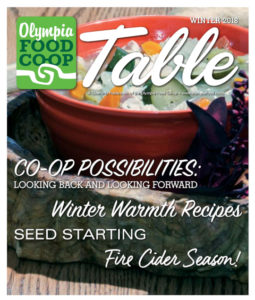Co-op Table Winter 2018 PDF
SEED STARTING
February marks the beginning of spring gardening in the Pacific Northwest because it’s the time we begin indoor seed starting. The whys and hows of this seemingly fussy process — with its many options and accessories — can be a bit mysterious and leave a novice gardener confused and overwhelmed. If that’s you, there are a lot of questions you are probably asking yourself as you stare at a display of grow lights and plastic trays. Since my goal is to alleviate the feelings of confusion and overwhelm that keep people from gardening, I will attempt to read your mind and preemptively answer some of those questions.
The first question you’re asking yourself is… “Do I really need to start seeds indoors?” The answer might be no (it is for a lot of people) and that’s just fine. The answer might be yes if any of the reasons below apply to you:
- You want to grow something that we don’t have a long enough growing season for. This would primarily be tomatoes, peppers, basil, celery, onions, leeks and eggplants all of which need more time and heat to mature in this climate.
- You want to get a head start on the season so you can get in multiple or longer harvests. People do this most frequently with brassicas (broccoli, cabbage, kale, etc.) and lettuces.
- You have slugs or other pests that will devour your seedlings if you direct seed in the garden. Many people find that they are less likely to lose whole plants if they start them in pots and wait until they are 3 – 4 inches tall to put them in the ground.
- You want a large enough amount of one exact crop, so that it will be more cost effective to grow starts at home than to buy starts later. If you only want 4 or 5 tomato plants and you want them all to be different varieties, starting them yourself at home doesn’t make a ton of sense. You will buy a bunch of seed which will mostly go unused and put a lot of energy (and possibly money) into keeping just a handful of plants warm and lit and watered. I invest my seed starting energy solely into those plants that I want at least a dozen of like Genovese basil (unless the next condition applies).
- You want to grow something obscure with a long growing season that you might not find starts for like okra, cardoon, or shiso.
- You need something to bring you hope and keep you entertained in the final days of winter, or you’re just a big garden nerd.
Okay, the answer is yes. So: “What plants should I start indoors?”
Hopefully the reasons above gave you some guidance in this respect. To further narrow the options a bit, some seeds are better started by direct seeding outdoors. These include peas, beans, root crops, chard and spinach, most Asian greens, corn, and winter and summer squashes.
A comprehensive list of what gets planted where and when is beyond the scope of this article, but the amazing Maritime Northwest Garden Guide breaks this down beautifully and is available at either Co-op (see sidebar at above right for more info). As always, I cannot recommend enough that you pick up a copy.
Local seed company, Uprising Seeds, also has good planting information for our area in their catalogs (available at both Co-ops) and on the seed packets themselves (logo pictured at left).
Now that you’ve worked out what plant you’ll be starting, the next logical question is “What will my plants need?”
Besides love and attention, there are some basic necessities, all of which have a bunch of options that I will try to break down for you as best I can:
A Growing Medium
My top recommendation for plants that won’t be in pots for too long is to simply use coconut coir. Coir is the hairy bits from a coconut shell. It usually comes compressed in a block that you soak in water to loosen up, and it has the excellent properties of both retaining moisture and having good drainage and having a near neutral pH. It doesn’t provide anything in the way of nutrition but a seed is packed with nutrients for the seedling to live off of for the first bit of its life, so it’s no biggie.
For plants like eggplant, tomatoes, and peppers that will live in their pots for quite a while, I recommend using a more complete potting mix that will provide essential nutrients to the plant. I love the super dreamy, peat-free, non-GMO potting soil from Malibu Compost, but if you have the time, making your own potting blend can be another fun winter garden project and more economical.
Containers
Most people use plastic cells and trays, the benefit being that they are all standardized so that cells fit neatly in trays and domes fit neatly over trays, etc- the downside being that it’s, well, plastic. There are biodegradable options as well made from plant fibers, manure, and wood. Theoretically, the fiber and manure pots can be planted straight in the ground and will dissolve away but score the pot before planting to ensure roots are not inhibited from growth. Many folks make their own pots by poking holes in yogurt containers or cutting toilet paper rolls in half amongst a million other creative solutions. Whatever you use, just make sure that water can drain freely from the pot and you have something to catch it when it does.
Light and Heat
The plants you are starting indoors are there because they need light and heat that the outdoors can’t provide them with. If your indoor space can’t provide them with adequate light and heat either, it’s all for naught, so this part is essential. Most vegetables need full sun (remember this means 6 hours of direct sunlight), and if you are reading this from western Washington in the dead of winter you probably aren’t getting this kind of light anywhere in your house, so you’ll need to provide full spectrum artificial light. There are regular style full spectrum bulbs that can fit in typical light fixtures. I prefer long, full spectrum tube style lights that are suspended above plants either from the ceiling or a special stand. There are also regular style full spectrum bulbs that can fit into a regular light fixture, because they distribute light evenly above the plants. This is helpful because if light is stronger in one place, plants will twist and bend to grow towards it. As for heat, your plants will be fine if you are keeping them in a heated room like your kitchen or living room, but if you need to start them in a cold space you will probably need a heat mat to keep them warm. Plastic domes can also help concentrate heat and light.
Water and Food
Most seeds won’t germinate if they are aren’t consistently moist, and seedlings are unlikely to survive drying out, so you need to make sure you keep our growing medium consistently moist. A spray bottle or small watering can with a small opening is ideal. Anything that waters too fast, too hard, or too much could dislodge seeds, damage young plants, and wash way, compact, or drench your growing medium none of which will be appreciated by your plants. Like I said, plants should have enough food from their seed to make it for the first while, but once the first set of leaves (these are called cotyledons and aren’t really leaves) are dying back and true leaves are forming, they will be running out of food. This is especially true if you used straight coir or a seed starting mix. An enriched potting soil should provide them with food for quite a while but watch for yellowing or purpling leaves which is a sign of nutrient deficiency. When you go to feed your starts you’ll want a liquid or soluble powder fertilizer, one that’s fairly balanced but higher in nitrogen to promote leafy growth (most fertilizers will have 3 numbers prominently displayed on the front standing for N-P-K- the primary plant nutrients- and you’ll be looking for one where the numbers are all fairly close but the first one is
the highest). I use liquid fish. It smells terrible but dissipates pretty quickly and after a while you’ll come to like the smell because of its positive associations with gardening (or at least I did).
And the final question… “When do I put them outside?”
The answer is variable, depending on the plant and the weather that year, but the seed packet should give you guidance. Usually, it’s somewhere between as soon as soil can be worked (sometime between March and April) for cool season crops to after last frost (May) for warm season crops. Whenever they get transplanted, it’s going to be a big shock for your plants to leave behind their cozy, coddled indoor life for the rugged outdoors. Big shocks can kill plants or leave them sickly and stunted, so you need to slowly acclimate them using a process called hardening off. This means for about a week you will put them in a protected outdoor location (like a porch or the side of your house) for a little bit every day, starting with an hour or two and increasing it by an hour every day.
If this all sounds a bit complicated and fussy, it is! But if you love doting on plants it’s all kinds of fun, and if you aren’t afraid to fail, you can experiment and figure out just what level of effort you need to put in to get a garden you can love.
Why does the Co-op recommend coconut coir?
Peat moss is still the main ingredient in almost every commercial growing medium, but the Coop has worked hard to carry alternatives to peat due to environmental concerns. Peat moss is a mostly non-renewable resource that is formed over thousands of years and stores massive amounts of carbon which are released into the atmosphere during harvest, contributing to global climate change.
By Sylvan Rook
Staff Member

